Ravenna
INTRO
Although it is very well-known among nationals, the quiet city of Ravenna, for no good reason, is still an underrated destination for foreign visitors. It might be because it has fallen into the shadow of other major tourist spots that exist around it, such as Bologna, Florence or Rimini.
We believe that it is never too late to discover the hidden beauties of our fascinating country, but we also see the problem: after all, we must admit that the Bel Paese has so many that it will take a lot of time to visit them all. Regarding time, don’t be concerned as we have plenty of it and, with us, you will never be pushed to rush through places. Moreover, it is precisely our mission to expand tourists’ knowledge about lesser-known places that not everyone hears about.

This is why we are more than happy to provide you with a brief introduction to this place which is full of unique and majestic mosaics and centuries of history.
A CITY OF HIDDEN MOSAICS
Ravenna has been a UNESCO World Heritage Site since 1996, with eight monuments listed, which is a remarkable achievement given its limited expanse. These exist because of the important role that the city played in ancient times.

Ravenna owes its splendor to Theodoric, king of the Ostrogoths, who turned it into the capital of its direct empire. This covered the whole extent of modern Italy, including Sicily, but not Sardinia, and also a large part of the Iberic peninsula, including part of the territory of modern Portugal and Spain, the French region of Provence and Dalmatia, in Croatia.

On this occasion, we will introduce you to only three of these eight unique places, to avoid spoiling the full surprise when you visit them in person.
Let’s have a look at them separately and discover why they deserve this illustrious title.
BASILICA OF SANT’APOLLINARE NUOVO
Built by Theodoric between the 5th and 6th century AD as an Arian chapel, it was later converted into an Orthodox church after the city was conquered by the Byzantine Empire. On the outside, visitors are welcomed by a simple façade, accompanied by the bell tower typical of Ravenna architecture. However, behind the plain exterior there is a rare treasure: a mosaic masterpiece dating back to Theodoric times showing 26 scenes from the life of Christ. This spectacular artwork is considered one of the most famous mosaic cycles in the world. Among the other precious scenes depicted, there is an image of the imperial palace—PALATIVM—created with a profuse use of gold, giving a marvelous overall effect.
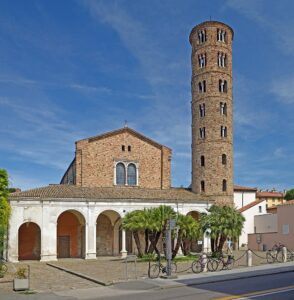
BASILICA OF SAN VITALE
Located in the heart of Ravenna, this basilica is probably one of the most visually impactful of the UNESCO sites. The beauty of its mosaics gently forces you to gaze all around you. Not only sideways, as you might imagine, but also upwards. You will often need to tilt your head backwards and move it in many different directions to follow the stories pictured on the wall, and even along the arches of the tall domes.
The scenes illustrate the celebration of the empire’s prosperity through coronations and important historical moments.

This is a fantastic testament to the religious and political power that the Byzantine Empire also had on Italian soil, which has been rendered in a delightful manner for us through this marvelous piece of art.
MAUSOLEUM OF GALLA PLACIDIA
Just behind the previous site, you will find one of the oldest buildings in the town. Although it was built to be her last resting place, the sister of the emperor Honorius, Galla Placidia (herself a ruler) was never actually buried here— sadly for her, we might say.
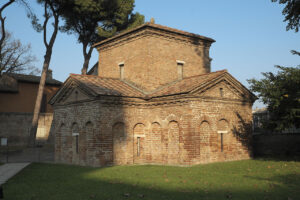
If you were passing by, you would never imagine that this plain-looking brick building would hide such astonishing pieces inside. The type of stories that are narrated within these walls reflect the nature of the building. Through a very fine version of the art of mosaics, here your eyes are in bliss watching the story of the Apocalypse, and the eternal battle between death and the afterlife.
The ceilings are completely covered with exquisite art, rich in detailed decorations and fascinating colors. Probably the most impactful mosaic covers one of the cupolas, and contains a magnificent indigo blue sky dotted with countless stars which are—literally—made of gold.
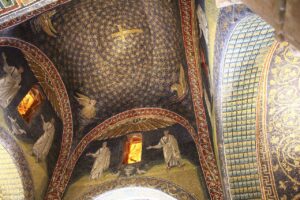
A STRANGE PROFILE
Don’t be surprised if, while walking around the town, you encounter the same peculiar images: a person dressed in a long red tunic that includes a separate head covering of the same color, usually embellished by a laurel wreath. His gaze towards the horizon seems to suggest he is absent-minded, but probably he is just holding focus on another intense thought, ruminating on the perfect sentence to create.
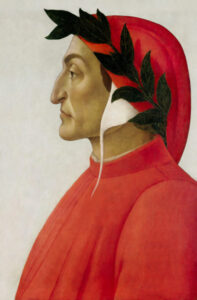
He is usually portrayed from the side, so as to highlight his most identifiable feature: the prominent nose, which adds even more character to his seemingly always-thinking face. If you are not familiar with those features, in Ravenna you will soon realize that they belong to the father of the Italian language, Dante Alighieri, the great poet, writer, and philosopher. It was here, in fact, that the poet returned in the last years of his life, invited by the local lord to work and complete his masterpiece, the Divine Comedy.
Beyond Dante’s Tomb, one can also visit the house where he lived, and a museum dedicated to him, which provides an interesting journey through his life and achievements, enhanced by the support of technology and worldwide acknowledgements of his literary genius.
FINISHING WITH A TOUCH OF NATURE
Once you have exhausted all the art-related options available to you, perhaps after a couple of days, or just in order to take a break outside the town, you will be happy to know that many other options lie close by.
The first and closest stop is Marina di Ravenna, the sea access to the town, eight miles to the northeast. If the beach becomes too crowded, and the cooling aquatic sports such as paddle surfing or canoe lessons aren’t enough, you can take an escape route behind the dunes and find shelter in the refreshing pine woods. In this restorative spot, you can learn about the local flora and enjoy some birdwatching.
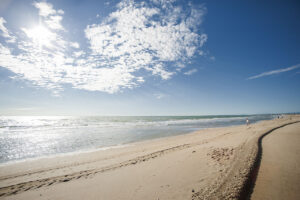
Not far from the town, heading south, there is the Delta Po River Park nature reserve, also a great destination for the whole family, on foot or by bike.
The pretty town of Comacchio, which we have introduced you to in the past because of its local gastronomic specialty, is also an interesting alternative that offers many reasons to visit, including the chance to admire the pink flamingos that populate its lagoons.
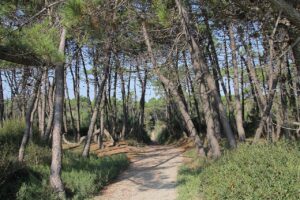
Another relaxing place to visit, immersed in nature, is the pine forest of Classe, not far from Ravenna city center. The ideal place for a silent retreat that the local people of the region have at hand, it will charm you too as it did many artists and eminent names over the centuries, and which has guaranteed it numerous literary references. The most prominent of these was Dante, who was so inspired by this place that he not only used the location as the scenery of his tales, but also placed some explicit mentions of it in his masterpiece.
Where would you like to start your own visit to Ravenna and its surroundings?
CONTACT US today to plan your next visit to the city of mosaics.
Words by Elisa Spampinato


